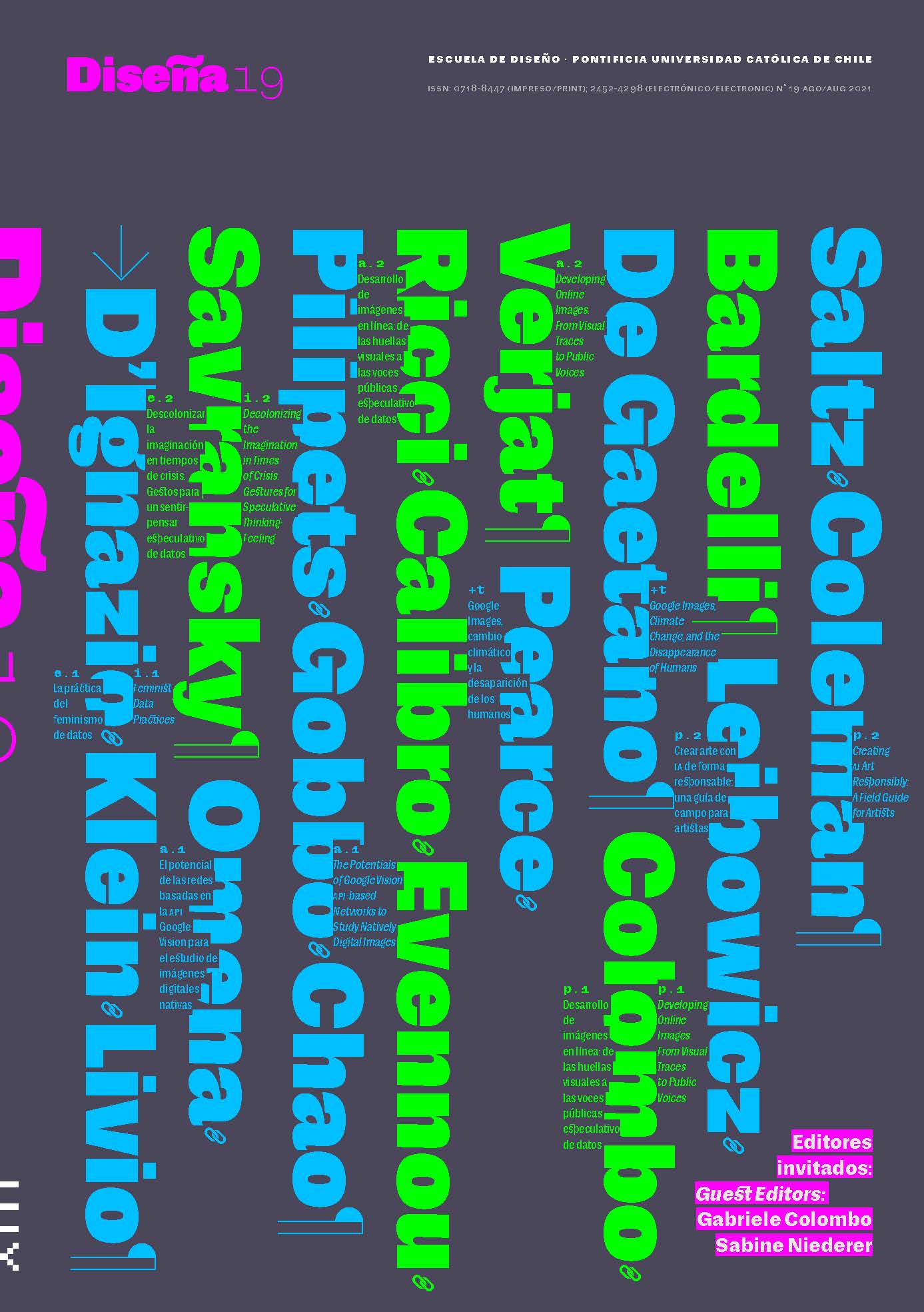Diseña 19 | Métodos visuales para imágenes en línea: recolección, circulación y co-creación con máquinas
Contenido principal del artículo
Resumen
En una sociedad saturada de imágenes, los métodos de análisis visual adquieren mayor urgencia. Este número especial explora las formas visuales de estudiar las imágenes en línea, centrándose en su recolección y circulación. La propuesta que hacemos es permanecer lo más cerca posible del material. ¿Cómo acercarse a lo visual con lo visual? ¿Qué tipo de imágenes se pueden diseñar para dar sentido, reconfigurar y reanimar las colecciones de imágenes en línea? ¿Cómo pueden las disposiciones de las imágenes en línea promover diversos procedimientos analíticos, acciones participativas e intervenciones de diseño? Además, nos centramos en el papel que pueden desempeñar las herramientas algorítmicas, incluida la visión artificial, en estos esfuerzos de investigación, sin dejar de ser sensibles a sus defectos y carencias. ¿Qué tipos de colaboración entre humanos y máquinas podemos prever para comprender mejor e interrogar críticamente la dinámica de la cultura visual digital actual? Las diferentes prácticas y formatos que se analizan en este número especial (como el feminismo de datos, las partituras visuales, la visión artificial, las redes de imágenes y las guías de campo) ofrecen una serie de enfoques que buscan comprender, reanimar y cambiar las perspectivas de nuestra cultura visual digital.
Descargas
Detalles del artículo

Este obra está bajo una licencia de Creative Commons Reconocimiento-CompartirIgual 4.0 Internacional.
NOTA DE COPYRIGHT
Todos los contenidos de esta edición electrónica se distribuyen bajo licencia Creative Commons de “Atribución-Copartirigual 4.0 Internacional” (CC-BY-SA). Cualquier reproducción total o parcial del material deberá citar su procedencia.
Los derechos de las imágenes publicadas pertenecen a sus autores, quienes otorgan a Diseña la licencia para su uso. La gestión de los permisos y la autorización de publicación de las imágenes (o de cualquier material) que contenga derechos de autor y sus consecuentes derechos de reproducción en esta publicación es de exclusiva responsabilidad de los autores de los artículos.
Citas
Aiello, G., & Parry, K. (2019). Visual Communication: Understanding Images in Media Culture. SAGE.
Bucher, T., & Helmond, A. (2018). The Affordances of Social Media Platforms. In J. Burgess, A. Marwick, & T. Poell (Eds.), The SAGE Handbook of Social Media (pp. 233–253). SAGE. https://doi.org/10.4135/9781473984066
Buolamwini, J., & Gebru, T. (2018). Gender Shades: Intersectional Accuracy Disparities in Commercial Gender Classification. Proceedings of Machine Learning Research, 81, 1–15.
Burkell, J., & Gosse, C. (2019). Nothing New Here: Emphasizing the Social and Cultural Context of Deepfakes. First Monday, 24(12). https://doi.org/10.5210/fm.v24i12.10287
Colombo, G. (2019). Studying Digital Images in Groups: The Folder of Images. In L. Rampino & I. Mariani (Eds.), Advancements in Design Research: 11 PhD Theses on Design as We Do in Polimi (pp. 185–195). Franco Angeli Open Access.
Crawford, K., & Paglen, T. (2019). Excavating AI: The Politics of Images in Machine Learning Training Sets. Excavating AI. https://excavating.ai
D’Ignazio, C., & Klein, L. F. (2020). Data Feminism. MIT Press.
Geboers, M. A., Stolero, N., Scuttari, A., Vliet, L. V., & Ridley, A. (2020). Why Buttons Matter: Repurposing Facebook’s Reactions for Analysis of the Social Visual. International Journal of Communication, 14(0), 22.
Geboers, M. A., & Van De Wiele, C. T. (2020). Machine Vision and Social Media Images: Why Hashtags Matter. Social Media + Society, 6(2), 2056305120928485. https://doi.org/10.1177/2056305120928485
Highfield, T., & Leaver, T. (2016). Instagrammatics and Digital Methods: Studying Visual Social Media, from Selfies and Gifs to Memes and Emoji. Communication Research and Practice, 2(1), 47–62. https://doi.org/10.1080/22041451.2016.1155332
Lister, M. (Ed.). (2013). The Photographic Image in Digital Culture. Routledge.
Niederer, S. (2018). Networked Images: Visual Methodologies for the Digital Age. Amsterdam University of Applied Sciences. https://research.hva.nl/en/publications/networked-images-visual-methodologies-for-the-digital-age
Niederer, S., & Colombo, G. (2021). The Earnest Platform: US Presidential Candidates, COVID-19, and Social Issues on Instagram. In R. Rogers (Ed.), Mainstreaming the Fringe: How Misinformation Propagates on Social Media. Amsterdam University Press.
Paglen, T. (2016, December 8). Invisible Images (Your Pictures Are Looking at You). The New Inquiry. https://thenewinquiry.com/invisible-images-your-pictures-are-looking-at-you/
Pearce, W., Özkula, S. M., Greene, A. K., Teeling, L., Bansard, J. S., Omena, J. J., & Rabello, E. T. (2020). Visual Cross-platform Analysis: Digital Methods to Research Social Media Images. Information, Communication & Society, 23(2), 161–180. https://doi.org/10.1080/1369118X.2018.1486871
Rose, G. (2014). On the Relation between ‘Visual Research Methods’ and Contemporary Visual Culture. The Sociological Review, 62(1), 24–46. https://doi.org/10.1111/1467-954X.12109
Sinders, C. (2020). Feminist Data Set. University of Denver. https://carolinesinders.com/wp-content/uploads/2020/05/Feminist-Data-Set-Final-Draft-2020-0526.pdf
Steyerl, H. (2013, November). Too Much World: Is the Internet Dead? E-Flux Journal, 49. https://www.e-flux.com/journal/49/60004/too-much-world-is-the-internet-dead/
Sze. (2018). Sarah Sze: Infinite Generation [Interview]. (L. Neri, Interviewer). Gagosian Quarterly, (Winter). https://gagosian.com/quarterly/2019/10/08/interview-sarah-sze-infinite-generation/
Tang, L., Fujimoto, K., Amith, M., Cunningham, R., Costantini, R. A., York, F., Xiong, G., Boom, J. A., & Tao, C. (2021). “Down the Rabbit Hole” of Vaccine Misinformation on YouTube: Network Exposure Study. Journal of Medical Internet Research, 23(1), e23262. https://doi.org/10.2196/23262
Tuters, M. (2020). Fake News and the Dutch YouTube Political Debate Space. In R. Rogers & S. Niederer (Eds.), The Politics of Social Media Manipulation (pp. 217–238). Amsterdam University Press. https://doi.org/10.2307/j.ctv1b0fvs5.9

